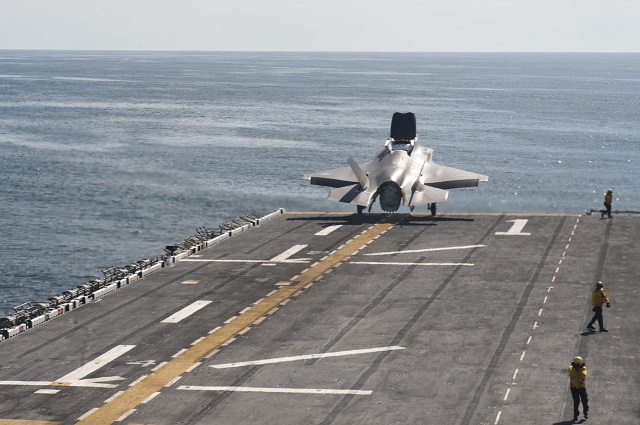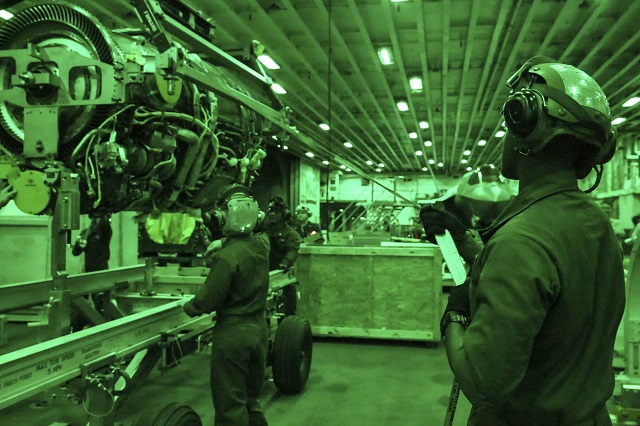Six US Marine Corps F-35B Joint Strike Fighters have departed the amphibious assault ship USS Wasp following a one-and-a-half-week trial that included 108 test sorties and an F135 engine delivery from a V-22 Osprey as the first combat fighter squadron stationed in Yuma, Arizona, prepares to declare initial operational capability this July.
According to deputy commandant for Marine Corps aviation Lt Gen Jon Davis, each of the 10 F-35 pilots involved are now qualified for daytime carrier operations and another three have received their night-time flying qualifications.
The six aircraft have accumulated 85.5 hours of flight time collectively since arriving on the USS Wasp May 18. Two squadrons participated: Marine Fighter Attack Training Squadron-501 of Beaufort, South Carolina, and Marine Fighter Attack Squadron-121 from the Air Station Yuma.

The squadrons will now continue their land-based preparations with the aim of passing a final operational readiness assessment due to take place over a two-week period in July if all goes according to plan.
“We’re going to run actual flight events with ordnance for all the mission profiles they’re supposed to be able to accomplish,” Davis said during a media teleconference from Oslo, Norway today. “Right now it looks like we’re tracking for that squadron to be able to declare initial operational capability in July, and when they think they are, we will confirm they are with an operational readiness inspection.”
The first squadron will become operational with 10 short-takeoff-vertical-landing (STOVL) F-35Bs, including some that are still being modified to correct deficiencies identified during testing. “There’s one airplane that may be a little late, but right now everything’s tracking to be on time,” says Davis.

The stint aboard the carrier focused on operational flying, but also on the logistics of maintaining the B-model on a ship using the autonomic logistics information system, or ALIS. The team was then able to evaluate the V-22 in its future carrier onboard delivery (COD) role by delivering a spare F-35 engine to the ship using a specially-designed rig. The Osprey flew the engine to the Wasp May 21 and departed with the weighty engine May 27.
The general says the logistics evaluation went well despite some complications like not having all the right parts and tools. The marines also trialled management and maintenance of the F-35’s low-observable coating to ensure its radar-evading characteristics could be maintained. “We proved we could do that at sea as well,” Davis says.

The Pentagon’s top acquisition chief Frank Kendall confirmed during the teleconference that the programme is making slow but steady progress and the marines and air force are on track to meet their IOC targets. The air force is hopes to stand up its first operational F-35A squadron at Hill Air Force Base in Utah by August 2016.
The F-35B is the most costly and complex of all three F-35 types and had experienced structural deficiencies and data fusion problems. The programme office is currently making corrections to the aircraft’s software to improve its data fusion capability. Those corrections are currently being tested as part of the Block 3i software load, and if successful those fixes will be installed on the Block 2B jets the marines will declare IOC with.
“We intend on taking that 3i software with the fixes to flight test around the last week of June,” says F-35 programme executive officer Lt Gen Christopher Bogdan. “We’ll be spending about 30 days flight testing those fixes, and if they appear to be good, then we will just leave those in 3i for the future airplanes and port them back into 2B.”
The Marine Corps has a requirement for 353 F-35Bs and 67 carrier-launched F-35Cs. The United Kingdom wants up to 138 F-35Bs for its carriers and Italy hopes to buy 30 STOVLs.

Source: FlightGlobal.com



















